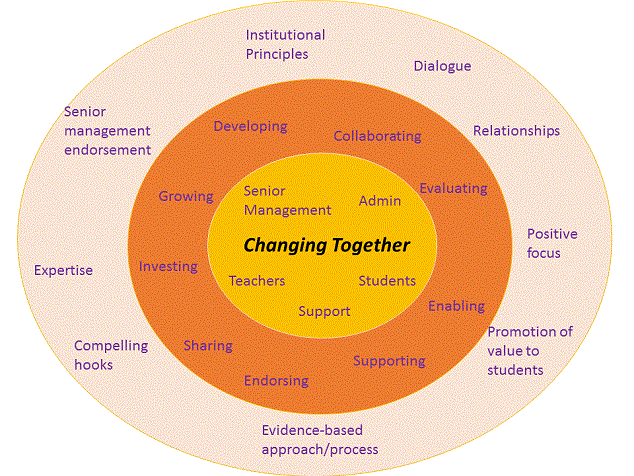e-AFFECT has developed an approach to change known as Changing Together. It is about Programme Teams, and School and central support staff, all working together to bring about change in the student experience of assessment and feedback.

The Changing Together Approach
An adaption of the Appreciative Inquiry1 change management approach, Changing Together focusses on the positive. It helps Programme Teams to reflect upon experiences of assessment and feedback which benefitted them as learners and then translate these into their own teaching. To do this they plan principle-based assessment and feedback activities supported by technology where appropriate.
Changing Together has a number of steps supported by resources outlined in the table below:
| Baseline activities | The baseline is a snapshot of experience, practice and perceptions of staff and students in programmes that opted to take part e-AFFECT. They are not a benchmark. The breadth of data gathered informs the programme team’s reflective activity within the appreciative inquiry and planning process. | |
| Appreciative Inquiry2 Workshop |
Informed by the baseline report and the literature review The particpants tell each other about their own high points of assessment and feedback (stories) and then their wishes for themselves their colleagues and the University and their dreams for a positive assessment and feedback experience for all. |
|
| Technology session |
This is a "sandpit" of Assessment and Feedback technologies with simultaneous one to one and small group demonstrations which particpants can "browse". Where available, academic and support staff from Schools who are already using the technology give the demonstrations representing their technology's community of practice. Training and support staff are also on hand.
|
|
| Action Planning session |
Staff look at their dreams and to think collectively how these might be brought about across the programme and at module level. Staff are asked to consider if the technology is appropriate for support of their proposed actions. At the end of the planning process a summary of the actions proposed by the programme team members, collectively and individually, is compiled into a document which is countersigned by the DE and Head of School. This signature is required to ensure these senior members of the School have cognisance of the outline of proposed developments. |
|
| Design and Development | Within development phase which follows these proposals are explored further with a view to implementation. This step might include a small trial with a pilot group. | |
| Implementation/Delivery | The innovative assessment and /or newly applied technology are trialled within the degree programme. | |
| Review and Embedding | A review of the implementation taking into account student & staff feedback takes place in time to inform the next iteration. | Action Plan template |
1, 2 Cooperrider, D & Whitney, D 2005 Appreciative Inquiry: a positive revolution in change Berrett-Koehler Publishers, Inc. San Francisco
Whitelock, D. & Cross, S. (2011). Assessment Benchmarking: Accumulating and accelerating institutional know-how for best practice. International Journal of e-Assessment (IJEA), Vol 1. No. 1 http://journals.sfu.ca/ijea/index.php/journal/article/view/18